Our Mt. Shasta Forest pond, Northeast of McCloud, 2012
This is how the pond looked when we first saw it on January 17th
(Click on all images to enlarge them).
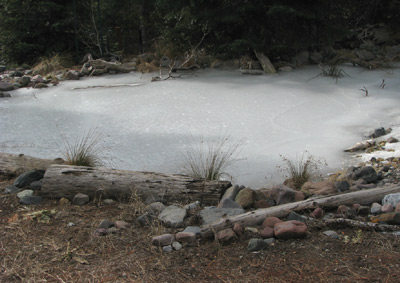
Not much snow this year - yet!
But then 2 days later the snows started in earnest as we had to hightail it home and didn't get back up until May.
May (Click on images to enlarge them)
So, the next time we saw the pond was May 7. It was mostly thawed (a little ice on the bog) but was taking a heavy hit on pollen:
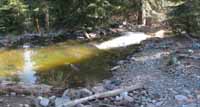
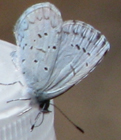
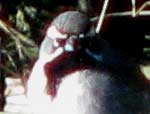
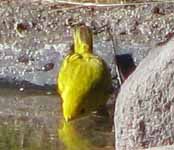
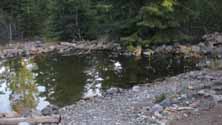
But, immediately the frogs were chorusing, our species #14 of butterfly - an Echo Blue - appeared (see above) and the
birds began arriving, including bird species #53 - the Black-throated Sparrow you see above...he was just passing thru on Spring migration however!
One of our favorite birds was also an early returner - the Yellow Warbler. And by the 8th, the pond was thawed.
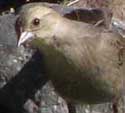 But by the 14th, the scourge of the pond was back....who is this 'devil'? - well, none other than the Brown-headed Cowbird.
You see, Cowbirds, like this female lay their eggs in other bird's nest, particularly the warblers that we love so much.
Plus, folks put birdfeed out and thereby feed the cowbirds, thus encouraging them, while Warblers eat only insects....
thereby providing us a service, besides being so pretty! Click on the female's image to be taken to a set of photos of them.
We had one male and six females forming a group this year :-(
But by the 14th, the scourge of the pond was back....who is this 'devil'? - well, none other than the Brown-headed Cowbird.
You see, Cowbirds, like this female lay their eggs in other bird's nest, particularly the warblers that we love so much.
Plus, folks put birdfeed out and thereby feed the cowbirds, thus encouraging them, while Warblers eat only insects....
thereby providing us a service, besides being so pretty! Click on the female's image to be taken to a set of photos of them.
We had one male and six females forming a group this year :-(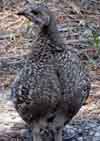
To balance the good with the bad, that's the same day that a Dusky Grouse hen walked up the driveway just ahead of Dave.
Click on her thumbnail to see several images of her! Her mate 'booms' up in the trees all Spring.
June (click on images to enlarge)
 The pond was back to life when I arrived with a friend in early June.
The bright green floating masses are duck weed that we brought up from our Sebastopol pond to help form shade for this pond.
The pond was back to life when I arrived with a friend in early June.
The bright green floating masses are duck weed that we brought up from our Sebastopol pond to help form shade for this pond.



This is the first year we've had Bog Bean or Marsh Marigold or Wide Leaf Water Plantain in the pond.
- They all have lovely flowers!
The birds that the pond attracts are always so lovely: Yellow Warbler, Chipping Sparrow, Western Bluebird,
Evening Grosbeak, Band-tailed Pigeon, Western Tanager, Yellow-rumped Warbler, Mourning Dove, McGillivray’s Warbler, and loathsome Brown Cowbird (why loathsome? Click
here)

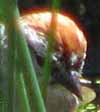


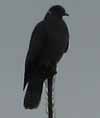



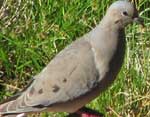
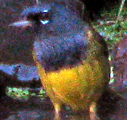
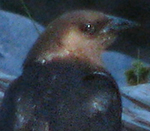
and the polliwogs were abundant!
The dragonflies amazed us! New to the pond was the Common Whitetail, a gorgeous white and black species!
And the "king" of the pond returned, the Twelve-spotted Skimmer
and the lovely male Cardinal Meadowhawk
The water striders were mating and Bumble Bees came out!
A Pale Swallowtail came in again and again for puddling.
July (click on images to enlarge)
When we returned in July (we spent the WHOLE month there!!), we found Variable Darners emerging from the pond.
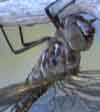 Undoubtedly these are the 'offspring' of the Variable that I saw ovipositing in 2011.
Many people don't realize that a dragonfly typically lives as an underwater nymph for about a year before emerging as a flying dragonfly.
Undoubtedly these are the 'offspring' of the Variable that I saw ovipositing in 2011.
Many people don't realize that a dragonfly typically lives as an underwater nymph for about a year before emerging as a flying dragonfly.
The pond itself was looking great....so wonderful that without anyone there to maintain it, the plants just grow as planned and the water remains clear.
A very special treat this month was adding not just one, but THREE, new 'life' butterflies to my list:
The Great Arctic, Hydaspe Fritillary and the Propertius Duskywing! And the pond was 'swarming' with pollywogs and salamander puppies!!
While the edges sported Western Fence Lizards and blooming Yarrow. We were happy to finally get an image of our most
common flycatcher, a Dusky. One of our does got named "Raspberry" after she stuck her tongue out at us!
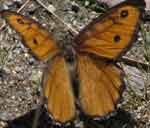
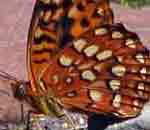
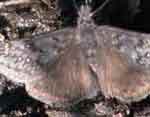
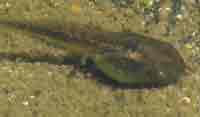
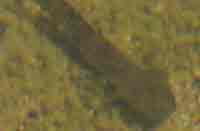
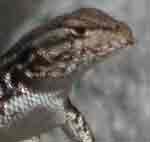
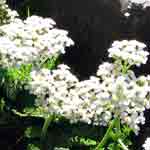
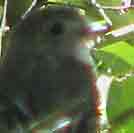

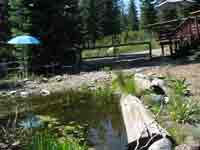
Sometimes I just can't believe I've created something so wonderful. Please click the image below to see the complete image of the pond.
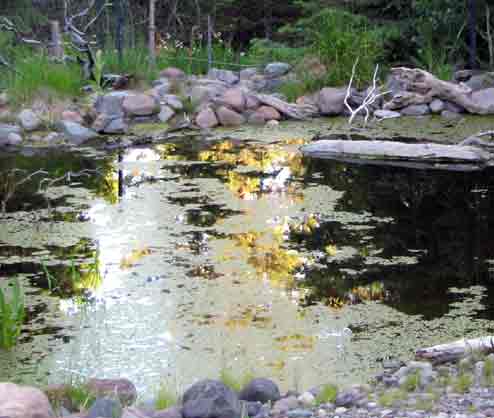
Other 'visitors' who came in for a drink &/or bath in July were Nashville Warblers and Juncos
(sometimes it's like it's 'raining' birds!!), and Pacific Fritillary butterflies. The elusive Golden-crowned Kinglet was barely captured. They just don't hold still. It's gratifying to find the native plants regenerating, as intended, wherever they feel at home.
I've also included an 'unusual' view - the house as seen across the pond from the bog. Do you like the 'stone wall' foundation? Or is it too easy to tell that I just painted them on?
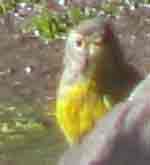

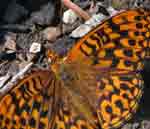
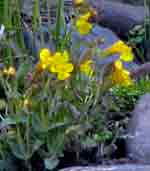
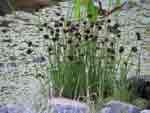
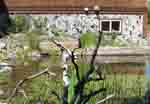
Some of our visitors are common, but we still enjoy our Robins, Bluebirds, and Audubon's Warblers. And although the Western
Tanagers are gorgeous, they are a very common bird at our pond.
And all the while, Mt. Shasta, the peak just 8 miles away, looks on. This photo shows her glowing pink at dawn. Please chick on her image.
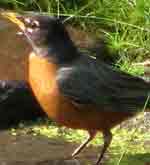
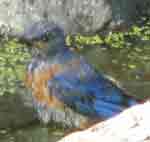

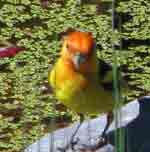
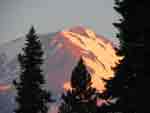
Spending a whole month at our McCloud home was wonderful and we were able to enjoy so many pond 'visitors'. The Lazuli
Bunting is Dave's favorite and for once they showed up when they weren't in pinfeathers!! And we had one, and one only, young Red Crossbill come in!!
The bog is functioning wonderfully, it is where our water input is, and by doing the input thru the bog area, we have nice clear water.
A bluebird family delighted us, and we had one 'mystery' bird that we finally figured out to be an Orange-crowned Warbler.
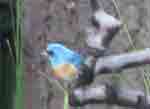
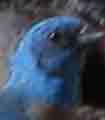
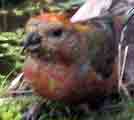
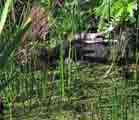
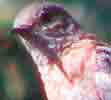
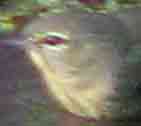
BUT BY FAR, THE BIGGEST EVENT WAS WHEN A BLACK BEAR CAME IN AT 8 AM AND TOOK A SWIM IN THE POND!!
Click on the image below to see images of this event!
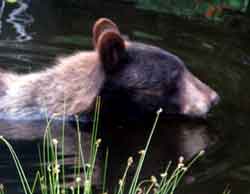
On July 19 a doe brought a fawn into the pond with her for the first time.
We were eventually able to identify 13 different deer, including does, fawns and bucks.
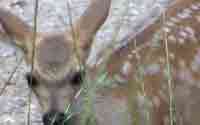
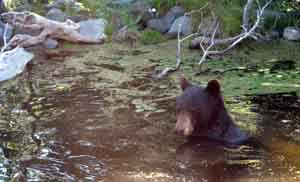
Then, at 2 in the afternoon on the 27th the same bear came back! We got both still images and 2 short 'movies'. One is up on YouTube.
We don't really want to encourage it to come in the middle of the day, although we're aware that it probably considers US to be the visitors! We've bought a marine airhorn to scare it away should it ever visit during daylight hours again.
August (click on images to enlarge)
We were able to stay a week into August and the month started out with more visits from the Western Bluebird family.
It was interesting that they preferred to take their baths from the 'floating' log in our pond. This is actually anchored. W
We put an eye-hook on the bottom of the log and they tied nylon cord to it and fastened an anchor rock to the other end of the cord.
This keeps the log from knocking over plants when it is windy. We do allow it to move a few feet though! All in all, we are really
happy with how this off-the-grid pond is maintaining itself. The plants are growing and establishing themselves,
despite the deer's browsing on them. We've widened the 'dry creekbed' walkway to make it look more natural, collecting
the sand and rock from a nearby creek.
We're only here usually for one week a month, but it was LOVELY spending a whole 4 weeks in a row here. A new species of dragonfly for the pond
was a Striped Meadowhawk who came looking for a mate.
When we went away for a dragonfly blitz, we were happy to find this image of a 4-point buck on our trail cam when we returned!
What a beauty!
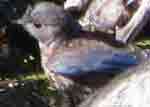
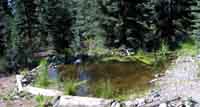


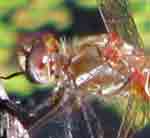
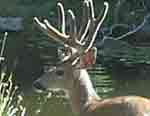
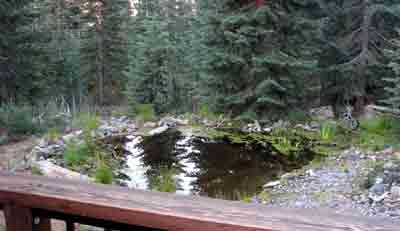
September (click on images to enlarge)
The same was true for the Chipping Sparrow. Other years they've apparently nested nearby, but not this year.
We were able to get a
set of wonderful images of a Variable Darner female ovipositing. This is a 'fall' species of dragonfly, so we wouldn't expect to find
them much before September.
We had hundreds of pollywogs become froglets, we knew that they'd disperse with the first rain.
An unwelcome visitor is the Yellow Jacket. We find if we trap these first thing in the Spring, we end up with queens, and thereby,
many fewer of these aggressive wasps.
Much more welcome are the beautiful California Sister butterflies. This one seemed pristine.
Another favorite, this one seen frequently is the White-headed Woodpecker. The image below is the female of the pair.
Bird #54 came in, it was difficult to ID, but with help we have determined that it was a Lark Sparrow!!
We were also able to ID another species of Dragonfly, the Shadow Darner - unlike the Variable Darner, this species has paired blue dots on the underside,
and 3 cells in the hind wing triangle...yes, Darners can be darned difficult to ID!!
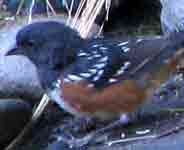
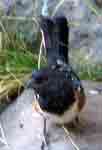
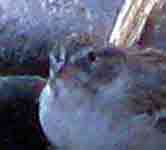
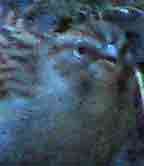
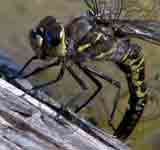
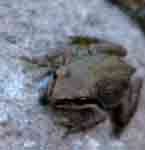
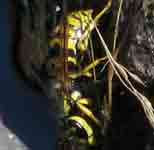
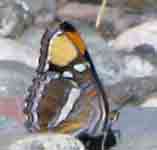
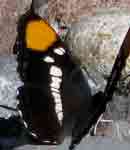
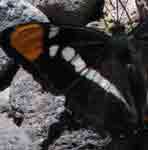
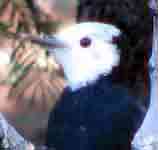
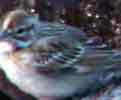
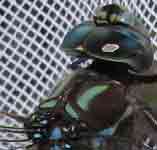
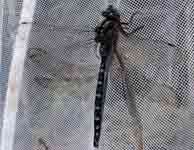
One thing we are trying to accomplish is to grow ONLY Siskiyou County, CA native plants on our property. One success has been
Goldenrod. Perhaps it grows in your area too, as it is widespread. In the 2nd image, a beautiful native red, black and white
beetle is nectaring on it. On the 20th, the White-headed Woodpecker male came in and we got his image,
this shot shows the red nape of the neck that marks this as the male of our pair. We've noticed that sometimes it seems to 'rain'
birds at the pond, such is the case with the Evening Grosbeaks often...they fly in, perch high in the white pines, and then just
drop, en mass, to the pond. See if you can count more than 24 in the Grosbeak image when you click on it!
The Pacific Chorus Frogs (renamed, used to be Pacific Tree Frog) came in all colors, sizes and patterns....they are capable of
changing color to match their environment. I esp. liked the one on the leaf, who hasn't turned the color of green yet!
Although the Fox Sparrow is one of our most common birds, or maybe because it is, we don't take many images of it. One is below.
We suspect that our Fall migrants may be a different race than our Summer breeders.
An unusual bird, for us at this location, and new bird #57 is the Townsend's Warbler, this one surely a migrant.
Then, on the 21st, we had to head back to our Sebastopol home and pond.
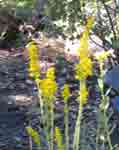
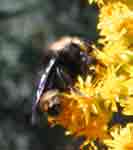
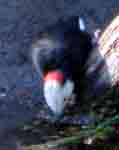
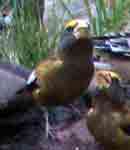
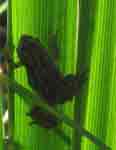
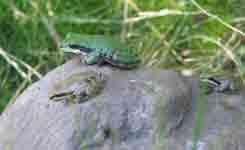
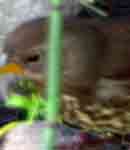
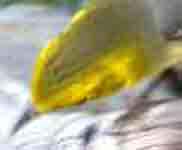
October (click on images to enlarge)
When we returned on October 14, we could see that the deer were enjoying the Blue Flag Iris in the bog! We really don't mind,
this IS a wildlife pond! It's for the critters enjoyment. And the Chickaree (squirrel) and chipmunks certainly do enjoy having the water nearby!
We were able to get pictures for the first time ever of Ruby-crowned Kinglets - such bouncy little birds. They mixed it up with
the Golden-crowned Kinglets and it was a lot of fun to watch them. I'm including a 'view out the kitchen window scene...it's a so
much fun to be able to watch the critters while doing dishes &/or cooking.
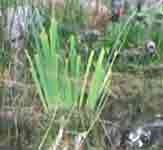
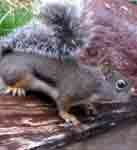
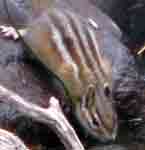
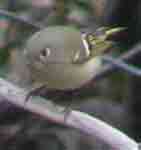
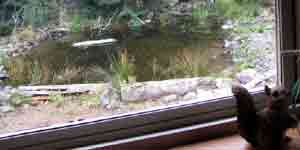
Migration is always an exciting time for us....and this visit didn't disappoint! Although the Flickers are here all summer,
this young one appeared to be a migrant. And then, for certain you know that fall has arrived when you see the White-crowned Sparrow.
It was EXCITING when we first heard, and then saw the Clark's Nutcracker! We had heard them a decade ago when we camped on our adjacent lot, but this is the first time they'd ever
been lured in by the pond - yay! Bird #58!! A pair of Band-tailed Pigeons became regular visitors and the Bluebirds continue to visit.
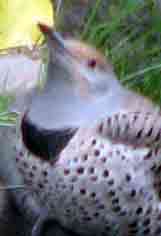
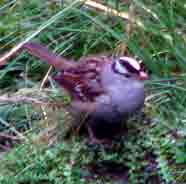
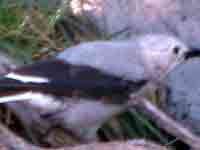
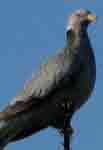
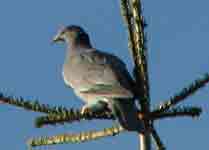
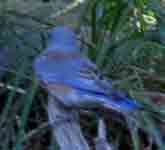
The weather was a nice temperature, so we chose this visit to complete some long-held 'dream' projects. One was to secure a
dead snag as a piece of pond art. So on the 19th that was our project! We had to use a come-along to get it up the hill and into the trailer to bring back - back-breaking work,
but we knew it would look great behind our pond, and make it look more natural. The hillside where the snag stood was so steep, we tied
Dave to the bumper to keep him safe! Then, to pull it up, besides using the comealong, we had to place some cardboard under it so that
it would slide smoothly. Finally we got it into the trailer and brought it back, but we lacked the time or energy to put it up!
That didn't occur until August of 2013 [last image; be sure to click on it]!
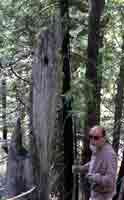
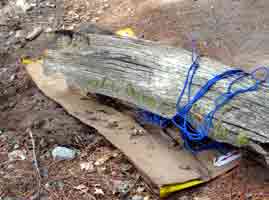
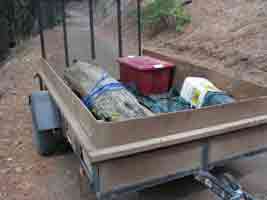
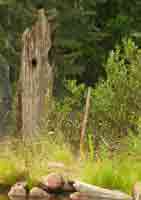
Our other big (Biggs?) project was to widen and expand the dry creek bed we started the year before. We built it because
whenever we went into the pond (for maintenance/building or just to cool down), we'd then track mud up the steps. By building a
walkway/dry creek bed we could both keep our feet clean, and it would look more natural. This was a big project because we had
to collect all our beach gravel and sand! It still needs more work, but the pond is better now than it was before!
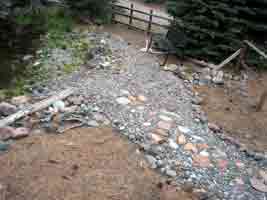
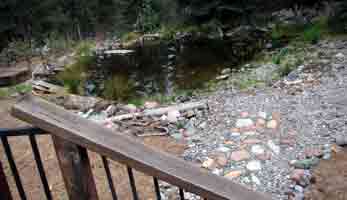
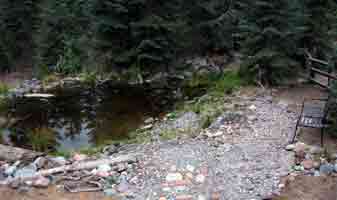
November (click on images to enlarge)
When we next returned, on November 16, the night had turned cold and the pond wore a thin layer of frost each morning. And by
the 18th, it was snowing and by the 19th it was sticking (our elevation is 5470'). It was time to winterize our McCloud home.
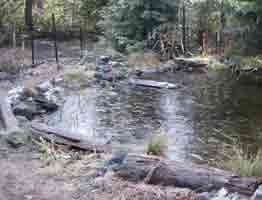
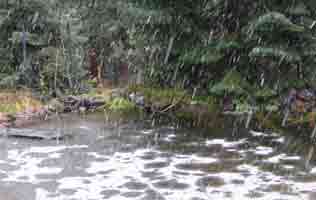
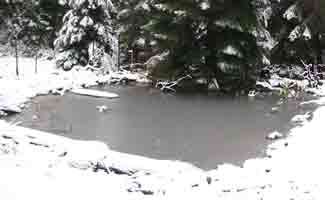
December (click on image to enlarge)
We didn't make it up to our McCloud home and pond in December this year because we had a HUGE pond project to do at our Sebastopol
pond - after 16 years, and a 50 year old oak tree falling into it, it needed to be completely emptied and rebuilt. You see, it didn't have
modern 45mil pond liner, it had much thinner, old old vinyl swimming pool liner in it, which had failed.
To see what that looked like on Xmas day, click on the tiny ugly thumbnail. That whole process will be completely recorded next year.
What was left showing in the image is the old blue-colored swimming pool liner, brittle and punched full of holes from when the oak
fell into the pond.

Please use your back/return key to return to the Bigsnest Wildlife Pond's entry page.
Thanks for visiting!
I always enjoy comments Kathy Biggs






 But by the 14th, the scourge of the pond was back....who is this 'devil'? - well, none other than the Brown-headed Cowbird.
You see, Cowbirds, like this female lay their eggs in other bird's nest, particularly the warblers that we love so much.
Plus, folks put birdfeed out and thereby feed the cowbirds, thus encouraging them, while Warblers eat only insects....
thereby providing us a service, besides being so pretty! Click on the female's image to be taken to a set of photos of them.
We had one male and six females forming a group this year :-(
But by the 14th, the scourge of the pond was back....who is this 'devil'? - well, none other than the Brown-headed Cowbird.
You see, Cowbirds, like this female lay their eggs in other bird's nest, particularly the warblers that we love so much.
Plus, folks put birdfeed out and thereby feed the cowbirds, thus encouraging them, while Warblers eat only insects....
thereby providing us a service, besides being so pretty! Click on the female's image to be taken to a set of photos of them.
We had one male and six females forming a group this year :-(
 The pond was back to life when I arrived with a friend in early June.
The bright green floating masses are duck weed that we brought up from our Sebastopol pond to help form shade for this pond.
The pond was back to life when I arrived with a friend in early June.
The bright green floating masses are duck weed that we brought up from our Sebastopol pond to help form shade for this pond. 













 Undoubtedly these are the 'offspring' of the Variable that I saw ovipositing in 2011.
Many people don't realize that a dragonfly typically lives as an underwater nymph for about a year before emerging as a flying dragonfly.
Undoubtedly these are the 'offspring' of the Variable that I saw ovipositing in 2011.
Many people don't realize that a dragonfly typically lives as an underwater nymph for about a year before emerging as a flying dragonfly.

















































































